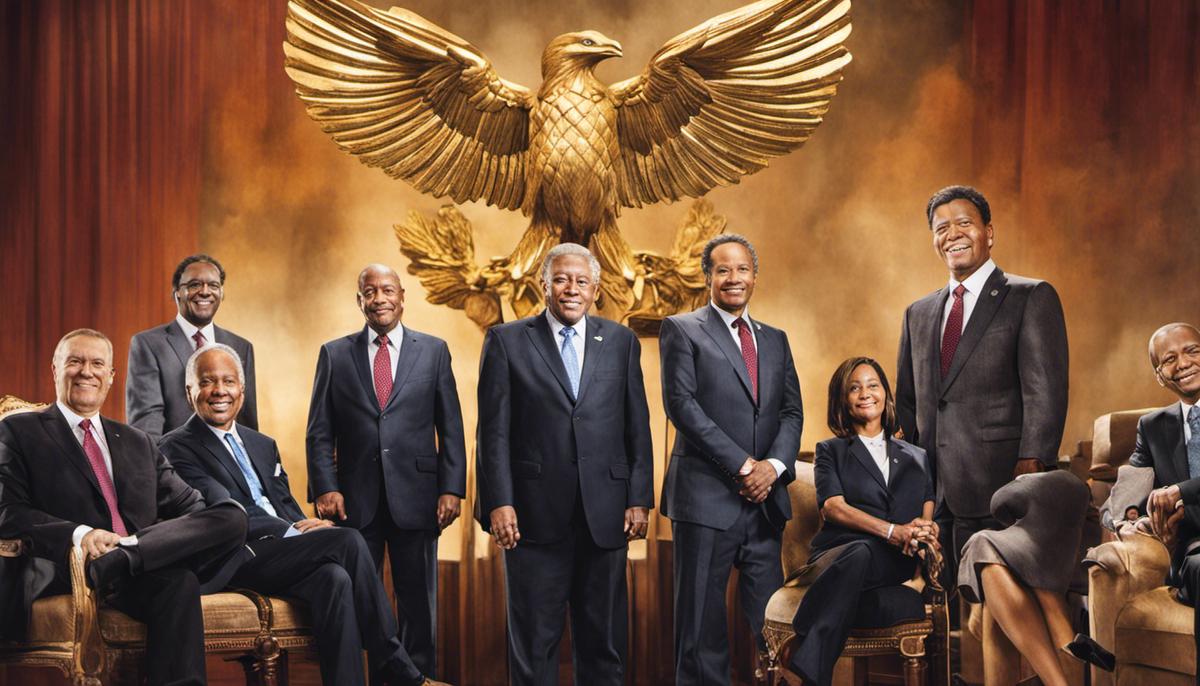The essence of leadership lies in its adaptability and responsiveness to the people it serves. One such approach is the Democratic Leadership Style, which offers a unique blend of shared decision-making, mutual respect, and team participation to arrive at effective outcomes. This leadership style thrives on open communication, distinctive values, and individual accountability to drive its organizational purpose. The differentiating factor of democratic leadership from other styles lies in its emphasis on collaboration, employee engagement, and a bottom-up approach to decision-making. It is through this exploration of democratic leadership that we illuminate its theoretical foundations, benefits, challenges, real-world applications, development strategies, and future scenario.
Basic Understanding of Democratic Leadership
Understanding Democratic Leadership
Democratic leadership, also known as participative leadership, is one of the many leadership styles recognized in the management field. It involves a process of decision-making that requires the active participation of all members involved in a group or organization. A democratic leader values input from team members, and their opinion in making decisions is welcomed, even though the final authority still lies with the group’s leader.
Adopting democratic leadership means adhering to principles of fairness, majority rule, equal participation in democratic decision-making, constructive dialogues, and shared responsibilities. Democratic leaders believe that through collaborative efforts and by giving individuals a voice, teams can more efficiently reach their collective goals.
Comparisons with Other Leadership Styles
In contrast to autocratic leaders who make decisions single-handedly, democratic leaders involve their followers or subordinates in the decision-making process. This can be considered as opposite to the laissez-faire style where leaders have minimal interference in the decision-making process and generally leave their subordinates to take the whole decision.
Foundational Theories and Key Characteristics
The democratic leadership style finds roots in Lewin’s leadership styles framework that distinguished three types of leadership – autocratic, democratic, and laissez-faire. His research suggested that democratic leadership yielded superior performance levels. This leadership style demands excellent communication skills, the capacity to encourage team input, and expertise in facilitating dialogues.
Democratic leaders create an environment where every member feels valued and respected. They excel in promoting cooperation within the team, rewarding creative thinking, fostering individual responsibility, and maintaining an open line of communication.
A Brief History of Democratic Leadership Implementation
Democratic leadership style has been adopted and implemented in a variety of settings across history. Leaders like Mahatma Gandhi and Winston Churchill implemented democratic leadership in different ways. In companies, Google co-founder Larry Page demonstrated democratic leadership by cultivating an open culture and fostering employee input in decision making.
From a political perspective, democratic leadership has been exemplified through the establishment of democratic governance in various nations worldwide, which allows the public to participate actively in the decision-making process.
This leadership style has been influential in many successful organizational changes, creating a sense of trust and loyalty among team members and improving productivity levels. Empirical studies have consistently shown a strong correlation between democratic leadership and high-quality group performance.
Conclusion
The democratic leadership style, while offering numerous advantages like fostering creativity, enhancing problem-solving skills, and heightening employee satisfaction, does not come without its challenges. The key to its success lies in striking a careful balance, ensuring everyone’s voice is heard without letting the decision-making process become overly drawn-out and time-consuming. However, if navigated correctly and rooted in a firm commitment to these principles, this participative leadership approach can considerably reinforce team engagement and overall productivity.

Advantages of Democratic Leadership
The Efficiency of Democratic Leadership
The democratic leadership approach lends itself to improved organizational efficiency by actively involving team members in decision-making processes. This inclusivity instigates a certain sense of responsibility among employees, often resulting in heightened workplace productivity and an increased enthusiasm for their tasks. Evidence underpins this theory with Gallup’s data revealing that workplaces with engaged teams are 21% more profitable.
In addition, organizations that adopt a democratic leadership style generally report fewer operational errors. Drawing from multiple perspectives during collective decision-making significantly reduces the risk of overlooking potential issues. Companies such as Google, which employs a democratic style of leadership, promote a collaborative culture in decision-making. This culture has been a driving force behind their continuous record of innovation and operational efficiency.
Democratic Leadership and Team Engagement
Democratic leadership significantly enhances team engagement. Allowing staff members the opportunity to voice their opinions and contribute ideas fosters an environment of respect, boosts morale, and increases engagement. A study by Aon Hewitt found that organizations with high employee engagement had an 18% increase in revenue per employee over a year.
Fostering Creativity through Democratic Leadership
Democratic leadership is also associated with heightened creativity within teams. As democratic leaders encourage open communication and feedback, more innovative ideas are often generated. A study published in the Leadership Quarterly Journal confirms that democratic leadership significantly relates to team creativity, by influencing creative self-efficacy and knowledge sharing. A prominent example of this was the democratic leadership style of Andrew Grove at Intel, which promoted an open-door policy stimulating innovative thoughts and ideas.
Democratic Leadership and Employee Satisfaction
A democratic work environment enhances overall employee satisfaction. Workers feel valued and respected when they are included in decision-making processes, leading to increased job satisfaction and employee retention. A study by the International Association of Business Communicators (IABC) found that employees working in companies practicing democratic leadership style reported higher job satisfaction rates and lower turnover intentions.
Fostering Personal Growth through Democratic Leadership
Adopting a democratic leadership style not only contributes positively to the collective but also fosters personal growth for the leader. By welcoming and valuing diverse viewpoints, leaders cultivate a holistic understanding of their team and organization. This broadened perspective enhances their empathy, resilience and capacity to solve problems effectively. Furthermore, it promotes their adaptability in the face of change. Evidently, Apple’s CEO, Tim Cook, credits this democratic leadership approach for enabling the integration of diverse perspectives in the decision-making process, supporting both his personal development and that of the entire team.

Drawbacks and Challenges of Democratic Leadership
The Duality of Time Constraints and Complexity in Democratic Leadership
Despite its considerable benefits, democratic leadership does have its drawbacks. A prime concern is the time-intensive nature of this approach. Encouraging open communication, fostering debate, and pursing consensus before finalizing important decisions can often slow down the process and can be particularly challenging when larger groups are involved.
Complexity of the decision-making process is another challenge inherent to democratic leadership. Since inclusive decision-making calls for all team members to be knowledgeable and competent, the leader is responsible for ensuring everyone can and is ready to contribute. This can be particularly complicated when dealing with specialized knowledge domains or complex problems.
Potential for Indecisiveness
The democratic leadership style may also lead to indecisiveness. As this approach values a consensus-based approach to decision-making, it avoids making decisions without collective agreement. However, in situations where the team is unable to reach consensus or are divided in opinion, this could lead to stalemate and hinder organizational progress. Moreover, this type of leadership style assumes that everyone has the capacity and will to participate actively, which may not always be the case.
Need for Frustration Tolerance
Democratic leaders may also have to deal with the feelings of frustration that can arise when consensus is not easily reached or when decisions take longer than expected. This can lead to emotional exhaustion or burnout for the leader and potentially decreased morale within the team.
Strategies to Overcome Challenges
Despite these drawbacks, there are strategies that democratic leaders can employ to mitigate these challenges. For example, clear guidelines for decision-making processes can help keep discussions focused and prevent them from becoming overly long or convoluted.
Additionally, democratic leaders can work to foster a team culture that values diversity of opinion and mutual respect. This can help prevent deadlocks during decision-making processes and ensure that disagreements are constructive rather than destructive.
To deal with the potential for indecisiveness or lack of engagement, leaders can use a variety of approaches. They might decide to make the ultimate decision after hearing everyone’s input, or they could assign specific roles and responsibilities that ensure each team member’s active involvement.
Finally, to avoid burnout, democratic leaders need to practice self-care and stress management techniques. They might find it useful to seek feedback and support from their peers, find time for relaxation, and ensure they have a healthy work-life balance.
The democratic leadership style, although prone to certain difficulties, can be managed effectively through meticulous preparation, efficient communication, and in-depth comprehension of the team’s dynamics.

Real-life Applications of Democratic Leadership
Applying Democratic Leadership in Business: The Case of Google Inc.
A sterling example of democratic leadership in the corporate realm is the tech behemoth, Google Inc. By structuring its management to foster employee input and involvement, Google paves the way for a dynamic work atmosphere. The company’s unique policy of allowing employees to dedicate a day each week to projects they are passionate about, even if unrelated to their core job functions, fuels a sense of creativity, enthusiasm, and innovation among its workforce.
Democratic Leadership in Politics: Barack Obama
In the world of politics, former U.S. President Barack Obama often displayed democratic leadership style in his administration. He would discuss important matters with his staff members and listen to their feedback before making final decisions. Obama’s leadership style often involved encouraging discourse and open dialogue between himself and his team members and thereby enhancing the team’s problem-solving capabilities.
Democratic Leadership in Academia: Harvard University
In academia, institutions like Harvard University utilize democratic leadership in its decision-making process, involving faculty members in decisions that impact the university’s future. The faculty members are encouraged to voice their concerns, opinions, and ideas, contributing to the overall productivity and positive outcomes of the institution.
Democratic Leadership in Medicine: Mayo Clinic
In the healthcare sector, Mayo Clinic employs the democratic leadership style. The organization encourages collaboration and feedback from its staff in patient care and innovation. Healthcare providers are encouraged to share their experiences and ideas. This democratic style leads to high employee job satisfaction and improves patient care outcomes.
Democratic Leadership in Non-Profit: Greenpeace
Within the non-profit sector, Greenpeace International is a good example of an organization embodying the principles of democratic leadership. They solicit input from all members of the organization and drive decisions and strategies based on this input. This democratic process ensures that their strategies align with their grassroots base, strengthening the overall mission of the organization.
Democratic Leadership in Sports: Phil Jackson
In the field of sports, renowned basketball coach Phil Jackson utilized a democratic leadership style effectively in managing his teams. Jackson was famous for his inclusive and consultative approach. He believed in creating a sense of ownership and shared responsibility among his players. Such a democratic approach introduced a level of balance and teamwork that led to collective success.
Overview
The democratic leadership style, characterized by engagement, collaboration, and shared decision-making, is a successful and proven approach applicable across diverse sectors. It fosters an environment of innovation, increased job satisfaction, and improved productivity, all beneficial to an organization’s growth.

Developing Democratic Leadership Skills
Implementing Open Communication as an Integral Part of Democratic Leadership
In democratic leadership, open and clear communication is a crucial component. It is the leader’s responsibility to integrate this aspect into the organization, ensuring staff members feel acknowledged, involved, and listened to. To foster such openness, leaders should share regular updates, encourage employee feedback and suggestions, and establish an open-door policy. Utilizing techniques like active listening, summarizing other’s thoughts, and seeking clarifications can enhance the quality of communication, demonstrating a leader’s active interest and clear comprehension.
Promoting Wider Participation Within the Team
Democratic leadership thrives on the active participation of all team members. Encourage employees to take part in decision-making processes and value their knowledge, skills and ideas. Instead of top-down orders, allow bottom-up ideas to flow freely in the organization. Using collaborative platforms, brainstorming sessions, and surveys can help foster a participative environment.
Empathy: The Key Ingredient to Democratic Leadership
Showing empathy is not about sympathizing, rather it is about understanding and sharing the feelings of others. This strengthens relationships, boosts collaboration, and fosters a harmonious work atmosphere. Regularly check in with your team members, be sensitive to their needs and problems. Be a keen observer, to monitor not just what your team members say but also watch non-verbal cues to understand and respond to their emotions effectively.
Training and Development Programs for Aspiring Democratic Leaders
Participating in leadership training and professional development programs can also help leaders to build and hone their democratic leadership skills. Such programs help understand and instill the traits and strategies vital for democratic leadership. Leadership workshops, seminars, mentoring, networking events, and e-learning are valuable resources that provide both theoretical knowledge and practical experience.
Building Resilience Through Democratic Leadership
Democratic leaders empower their team members and prefer to take decisions collectively, but that doesn’t mean they evade responsibility during crises. Building resilience to handle such situations should be a part of any leadership development program. Learn the art of constructive criticism, accepting failures, and turning them into a learning experience, not just for self-improvement, but also to inspire others.
Developing Emotional Intelligence in Democratic Leadership
Emotional intelligence enables democratic leaders to connect on a human level, significantly contributing to a healthy organization culture. Improve emotional intelligence by practicing self-awareness, developing social skills, cultivating empathy, and mastering emotion management. Use a range of techniques from mindfulness to cognitive reframing, to increase emotional intelligence.
Continuous Learning and Adaptability in Democratic Leadership
Democratic leaders are not born overnight. It’s a continuous process that requires learning from experiences and adapting to changes. Be open-minded, welcome feedback, learn from mistakes, and be flexible in adjusting your strategies and techniques. Stay abreast with the latest trends and apply them to your leadership style.
Ultimately, mastery of the democratic leadership style, like any other, requires a grasp of its fundamental principles and the ability to evolve and adapt to changing situations. Success hinges upon being able to effectively foster open lines of communication, invite and value contributions from each team member, demonstrate emotional intelligence, and exhibit resilience. In addition, personal growth and improvements in these areas through ongoing training & development are necessary for developing into an accomplished democratic leader.

Future of Democratic Leadership
The Influence of Flexible Work Arrangements on the Democratic Leadership Style
Due in part to an increasingly digital world, the escalation of flexible work arrangements could drastically impact the utilization of the democratic leadership style. As the nature of work transitions towards a virtual or hybrid model, it is incumbent upon leaders using a democratic approach to adjust their strategies accordingly.
In an environment where team members are geographically dispersed, leaders must work harder to cultivate and maintain an inclusive and engaging culture. This includes involving remote employees in decision-making as they would those in the office, valuing their feedback, and tolerating opposing viewpoints. These measures, indicative of democratic leadership, can present unique challenges in an environment where physical meetings are less feasible.
To work around this, leaders may need to exploit technology and modify their organizational structures to ensure teams can collaborate effectively, and that the democratic process of decision-making is not hampered by virtual communication. Innovativeness and adaptability will be key to maintaining and furthering the democratic leadership’s goal of inclusivity despite the logistical complexities presented by remote and flexible work scenarios.
Influence of Technological Advancements on Democratic Leadership
As technology continues to evolve rapidly, it will inevitably shape the environment the democratic leadership operates in. Technological advancements such as AI, automation, and advanced analytics can help democratize decision-making processes by offering insights from vast amounts of data.
Leaders could harness the benefits of these technologies to facilitate more informed and open discussions. This technology can help the team members have equal access to the same information, enabling them to participate knowledgeably in decision-making processes. However, the successful integration of these technologies requires leaders to strike a balance between leveraging these tools effectively and still preserving the human touch inherent in democratic leadership.
Generational Shifts and Democratic Leadership Style
Finally, as older generations retire and younger generations move into leadership roles, we are likely to see shifts in prevalent leadership styles. Millennials and Gen Z employees tend to favor more transparent, collaborative, and inclusive workplaces, which aligns well with a democratic leadership style.
Research has also found that these younger generations are more likely to want to work in environments where their voices heard, and their ideas are valued. It suggests a future where democratic leadership could become even more popular as per the generational demands in the workplace.
That being said, younger generations also grew up in a digital age and might expect leaders to incorporate more technology in decision-making processes. Democratic leaders will have to consider this generational shift effect on various facets such as technology comfort levels, communication preferences, and expectations for transparency and inclusion.
Summary of the Impact
In summary, the future of democratic leadership looks set to involve more digital and flexible working arrangements, leveraging technological advancements, and catering to the demands of younger generations entering the workforce. The core principles of democratic leadership—collaboration, inclusivity, and shared decision-making—remain timeless, but the means and strategies to achieve them will continue to evolve and adapt to a changing world.

As our understanding of leadership continues to evolve, it’s evident that the Democratic Leadership Style offers a compelling paradigm for fostering a cooperative and engaged work environment. The implications of investing in such leadership style extend beyond mere operational efficiency, paving the way for enhanced creativity, elevated job satisfaction, and transformative personal growth. Despite its inherent challenges, the benefits and widespread applications of democratic leadership are undeniable, serving as a testament to its enduring relevance. However, with the advent of flexible work arrangements, technological advancements, and generational shifts, the ideology of democratic leadership faces a fresh array of challenges and opportunities.
